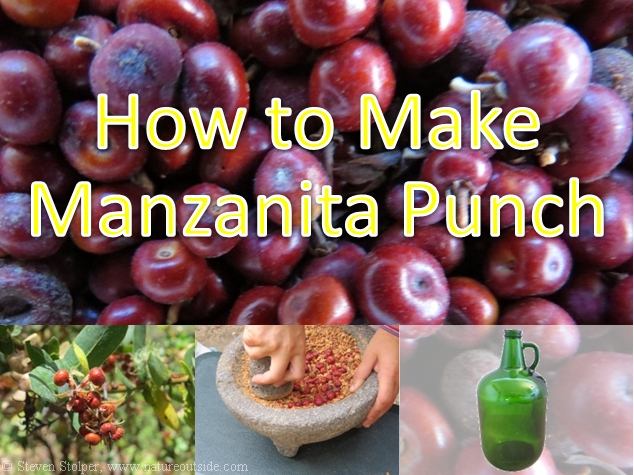
Summer is drawing to an end. And if you’re an animal it is time to store calories for the winter. Plants know this and provide a bounty of nuts and berries to entice us to disperse their seeds.
It’s a fun time to be a forager. In California, Acorns and Bay Nuts appear as if transported from the Starship Enterprise. Huckleberries leap out from the bushes demanding to be gathered.
And one of my favorites, Manzanita (Arctostaphylos sp.), gifts us its wonderful berries… Ahem, I mean drupes.
Drupes, Poison, and a Little Flesh
When the Spanish arrived in California, they found the native inhabitants harvesting berries that look exactly like miniature apples. The Spanish named the plant Manzanita, meaning “little apple.” And not only do they look like apples, Manzanita berries taste like apples!
Technically, the berries are drupes. Drupes are fleshy fruit with thin skin and a large central stone containing the seed. Plums, cherries, almonds, and olives are all drupes.
Manzanita berries are green when they form and begin to ripen in July. They really do look like apples! Their flesh is rich in vitamin C, potassium, and carbohydrates. At this time of year I look for undigested Manzanita berries in coyote and deer scat. It’s hard to miss! Woodrats, raccoons, and California quail all feed on the berries.1
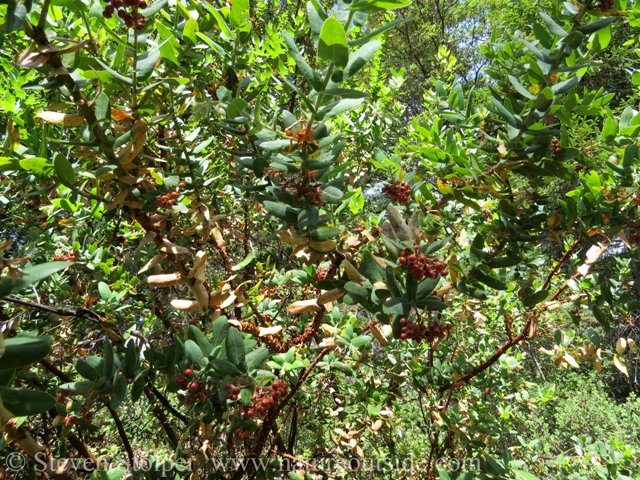
A Manzanita loaded with berries
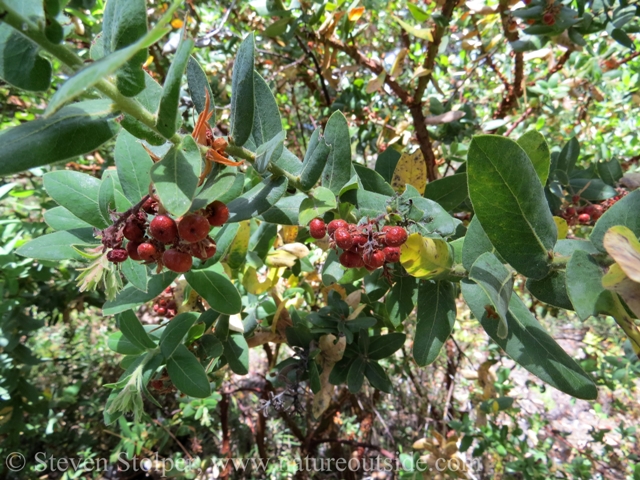
The berries are held in clusters hanging below the branches.
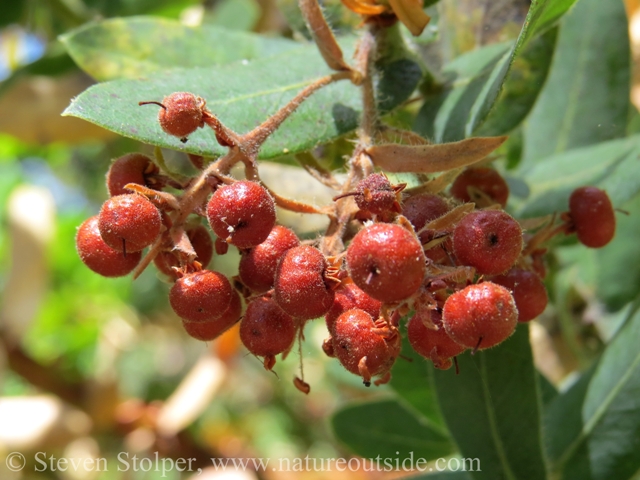
Manzanita berries really do look like little apples.
But just because animals eat them, don’t assume they’re safe for humans. The stone in the center of the berry contains hydrocyanic acid (HCN). Hydrocyanic acid is a colorless, volatile liquid that has the faint odor of almonds. Many plants use HCN as a deterrent against herbivores. That’s why so many edible plant books warn you to beware of plants with an almond smell or taste.
Cyanide is no laughing matter. Consumed in quantity it is a powerful poison that inhibits cell respiration. Your cells asphyxiate even though your blood is oxygenated. Cyanide also affects the central nervous system.
But don’t be frightened! Apple seeds contain the same chemical. And we eat apples all the time! We just don’t eat tons of apple seeds. The same can be said of Manzanita seeds. The amount of HCN is very low.
I could not find consensus among reputable sources as to whether Manzanita stones pose a health risk when making the punch. So I choose to separate the stones from the fleshy fruit so there is no chance of releasing HCN into the punch. Several of my friends prepare the punch with the stones. They just take care not to crack them when grinding the berries. The stones are relatively hard, so it is not difficult. I have prepared the punch this way occasionally and am still in good health. But my personal choice is to discard the stones (see steps below).
Where do I find them?
There are more than 60 species of Manzanita around the world. In California, they grow predominantly in the chaparral environment. Chaparral is an arid environment consisting of drought-resistant shrubs.
Many plants that live in chaparral are armed with vicious thorns. When the Spanish cowboys rode their horses through chaparral, the plants ripped at their pants until their legs bled. That is why they wore special leather pants that had material only on the outside of the legs. These chaps protected them from the chaparral plants.
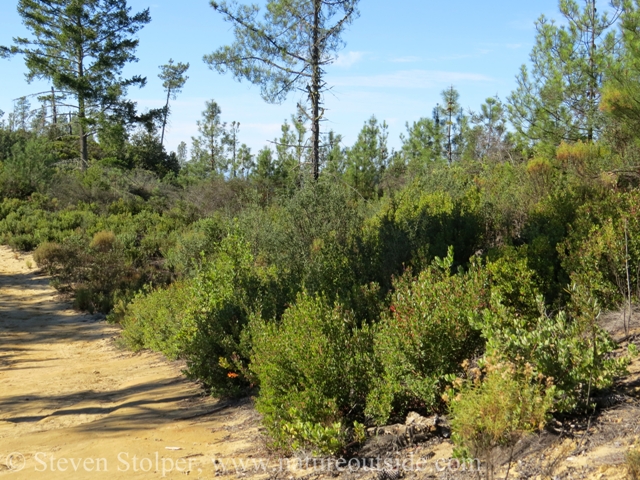
Coastal chaparral is strangely beautiful.
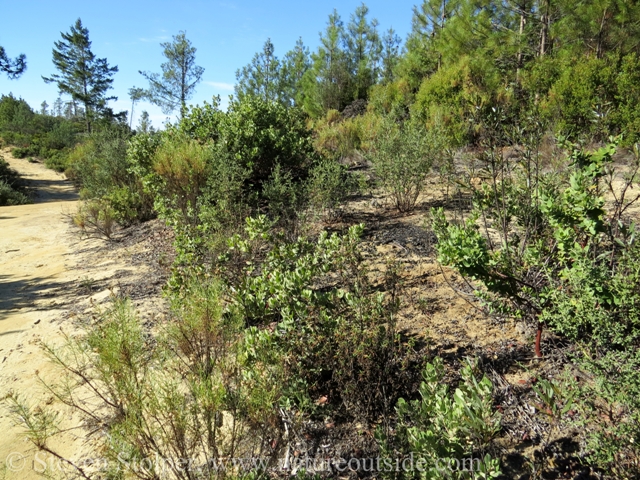
All the plants are adapted to the dry climate. They have thick waxy leaves to help conserve water.
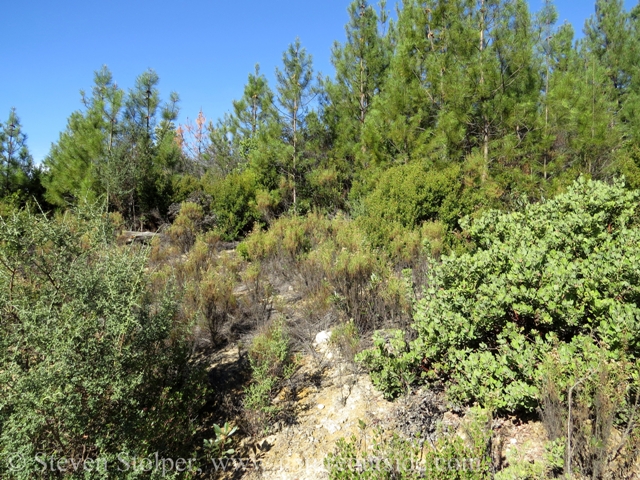
Fire was common in chaparral. Many of the plants rely on fire to reproduce.
Show me that Naked Plant!
Manzanitas are beautiful to look at. They are cousins of the refrigerator tree. So they have smooth trunks and branches covered by thin red bark. And like their cousins, they shed their bark seasonally to expose beautiful “naked” branches of pale green. Why do they do it? The most popular theory is that shedding its thin bark helps to rid the shrub of parasites. The results are stunning. These beautiful, sculptural, bushes would look at home in the finest art museums. Their waxy two-tone leaves further enhance the effect.
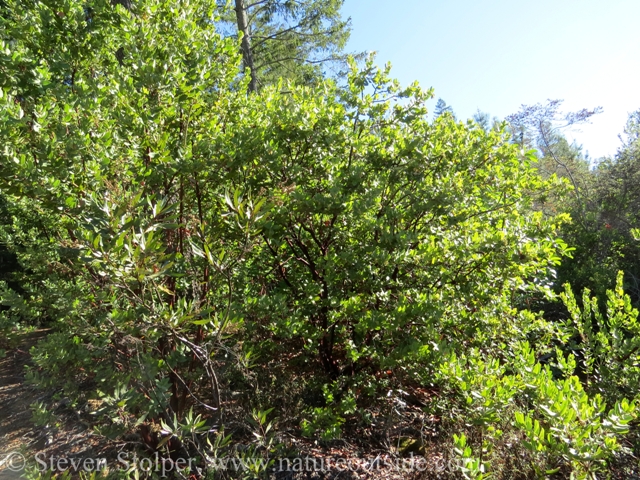
Manzanita is highly sculptural woody shrub
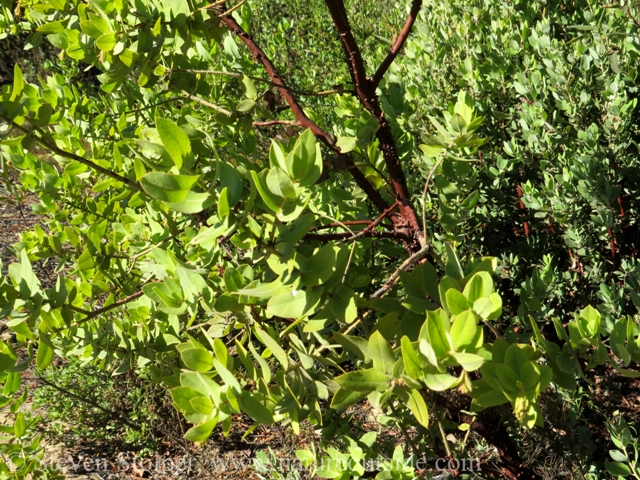
It’s thin red bark gives it a “naked” appearance even before it peels off to expose the pale green wood below
Traditional Uses
Books will give you myriad ways indigenous Californians used Manzanita. But two common uses supported by research are to treat urinary tract infections and as a delightful fruit punch.
I Gotta Pee
Make no mistake, Manzanita leaves contain powerful medicine. Their use to treat urinary tract infections has been borne out by science. Research using Arctostaphylos uva ursi shows that Arbuten, a chemical in Manzanita leaves, breaks down in the body to become the anti-bacterial, hydroquinone.
But hold on! While effective, this potent medicine and can be very dangerous. Hydroquinone can cause serious liver damage. Using Manzanita safely requires a very specific regimen. For this reason, I do not teach people how to use Manzanita in this way. Conventional medications exist to treat urinary tract infections and carry fewer risks.
I Need a Drink
I recommend you use the berries to make a delightful fruit punch. Native Californians used this cider to stimulate appetite before a meal. The Sierra Miwok sucked their cider through straws made from hawk tail feathers.2
In the remainder of this article, we’ll talk about how to make the punch.
I should mention that it is safe to nibble the flesh from the berries, as long as you do not consume the stone. I generally pop a berry in my mouth and use my teeth to scrape the flesh from the stone. Then I spit the stone. Swallowing a stone won’t kill you. But I don’t recommend it.
How the Traditional Punch Is Made
The Ohlone Peoples, the original inhabitants of my area, made Manzanita punch. Their descendants explained to me that they grind the berries to separate the thin flesh from the large stones.
I was originally fearful of using force to grind them. I worried that damaging the stones would release HCN into the cider. But the women I spoke with showed me that, with reasonable care, the stones are so hard they remain whole throughout the grinding process.
Accounts I read say that tribes winnowed the ground Manzanita berries in a woven basket to separate the seeds from the flesh and skins. After discarding the seeds, they place the berry pieces into a basket and pour water through them. Water passing through the mixture is collected in a water-tight basket below. This water is poured through the mixture repeatedly. Each time, it gains more flavor from the berries. The process reminds me of making coffee.
When it is strong enough, the punch is consumed.
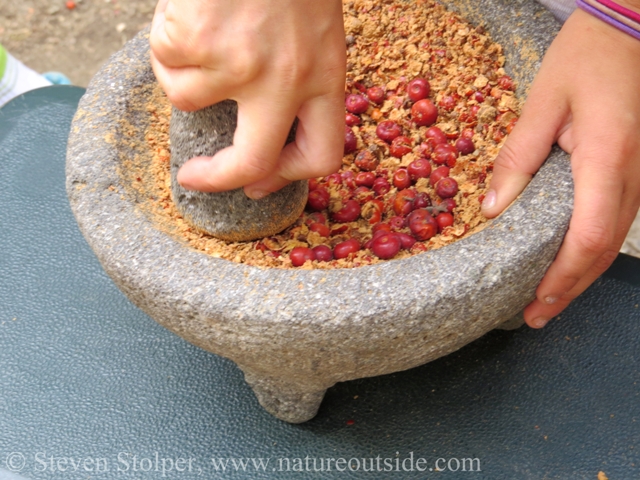
Grinding the berries outside using a stone mortar and pestle
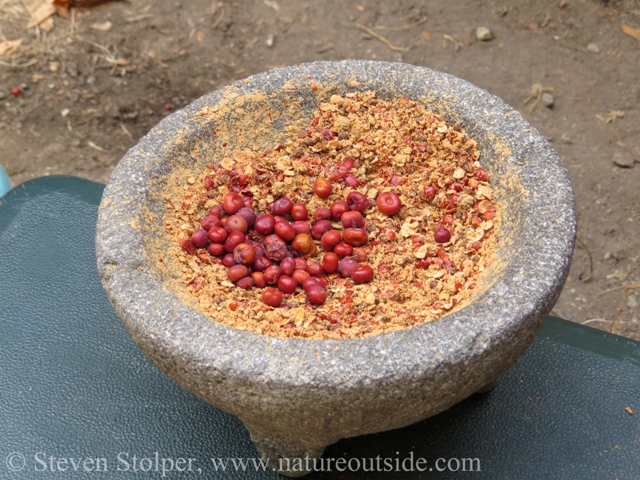
Ground Manzanita berries
Let me Punch You
Let me show you how I make Manzanita Punch. My technique differs from the traditional one for three reasons:
- I have water-tight containers
- I have time to let the mixture sit
- I have refrigeration
The infographic below summarizes my procedure.

And here are the steps in detail:
1. Wash the Berries
The berries may be dirty. And you undoubtedly collected debris and unwanted plant material when you harvested them. So it is very important to wash the berries before use. The berries of several Manzanita species are very sticky. So wash the berries thoroughly before using them.
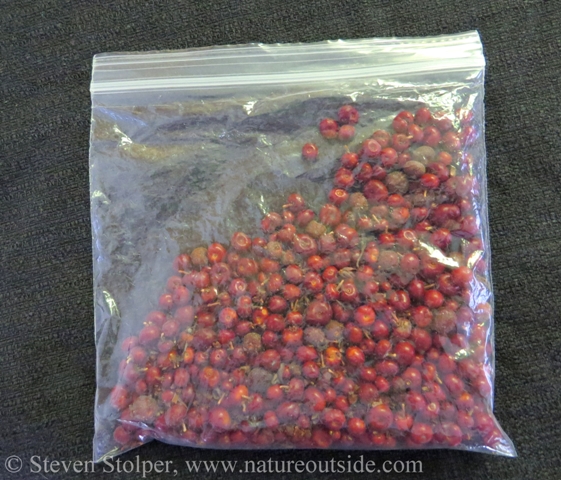
I start with fresh berries I collected. But you can also freeze the berries to preserve them for later.
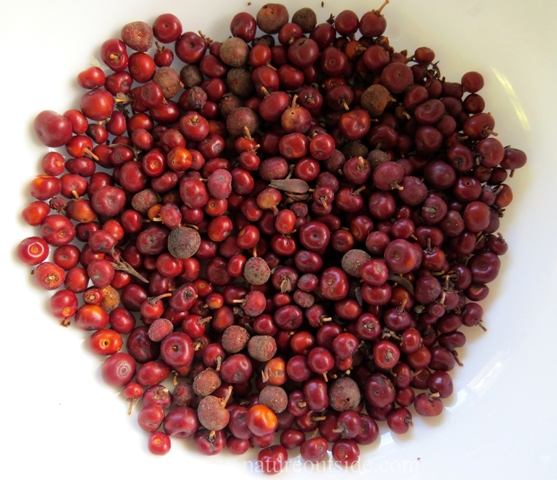
The berries may have dirt on them and the berries of some Manzanita species are sticky.
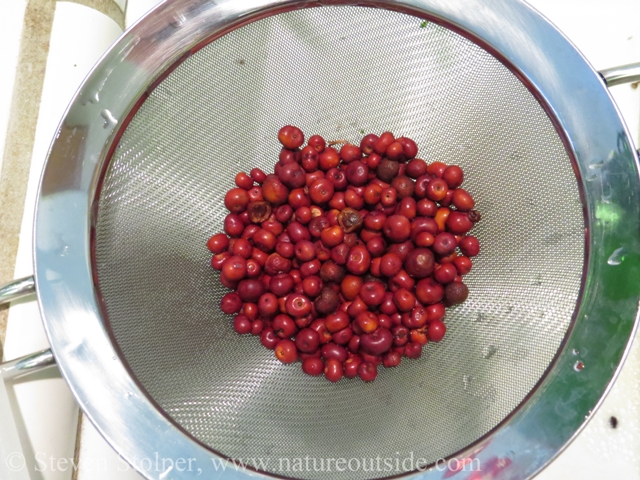
I place the Manzanita berries in a strainer and wash them under the faucet.
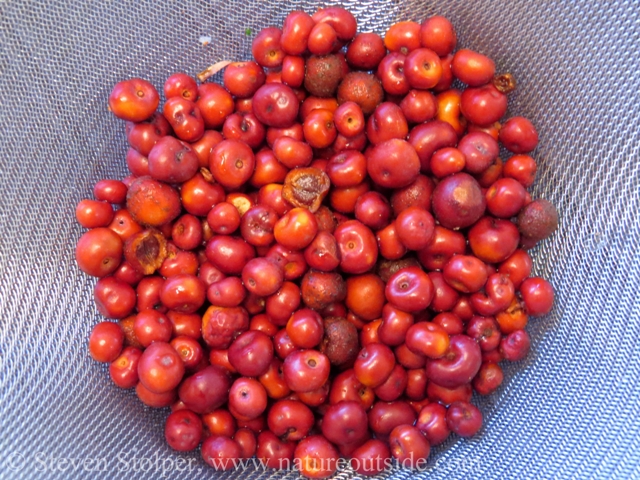
The washed berries. In this picture, you can see the stones of some of them.
2. Crush Berries
Use an inexpensive wood mortar and pestle to grind the drupes. Make sure not to crack the stones. Remove the stones from the mixture after grinding and discard them.
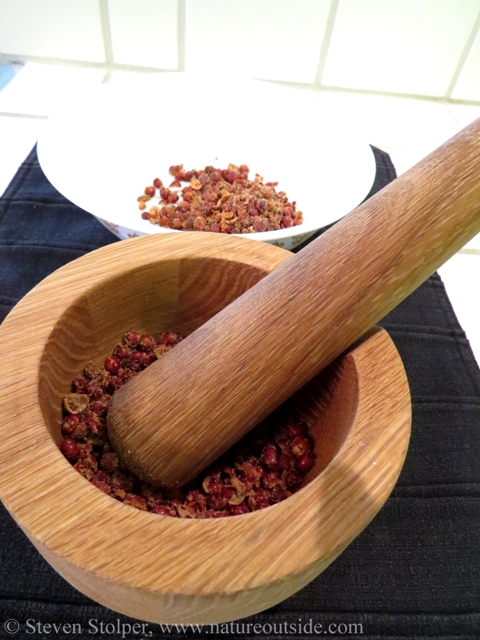
I use an inexpensive wood mortar and pestle to grind the berries.
3. Place in Carboy
Place the berry pieces into a gallon capacity glass carboy. You can pick them up in stores or on websites that sell brewers supplies.
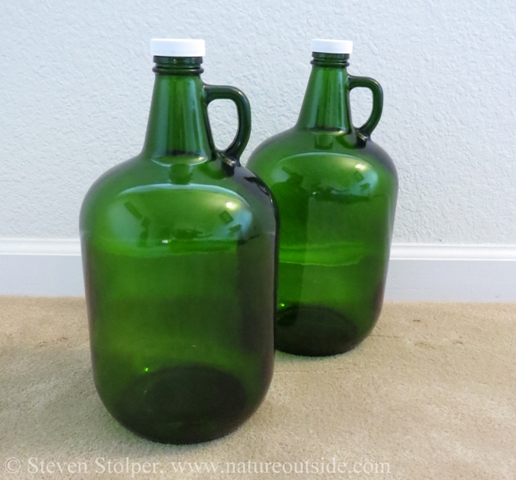
The two carboys I use to process Manzanita berries
4. Add Hot Water
Pour hot water into the carboy. Do not use boiling water that might destroy vitamins in the berries. Boil the water and let it sit a short time before pouring it into the carboy.
5. Let Stand
Place the cap on the carboy and let it stand in a cool area away from direct sunlight. The longer it sits, the stronger your drink. One day yields a light, refreshing drink a lot like flavored water. After three days it has a strong taste you’ll either love or hate. Do not let it stand more than three days or you risk bacterial growth.
The berries initially float on top of the liquid. But over time they sink to the bottom of the carboy.
6. Strain into Second Bottle
The goal of this step is to remove the berry pieces from the liquid.
Decant the liquid from your first carboy into a second. Instead of a second carboy, you can choose other types of bottles.
When you pour the liquid, use a funnel to ensure you don’t spill. You can purchase the funnel when you buy the carboys.
Place a thin strainer over the funnel to filter out the berry pieces. Alternatively, you can place a coffee filter into the funnel. I recommend the strainer because I believe small pieces of berry in the final bottle adds to the flavor.
7. Add Sugar to Taste
The drink is more sour than our modern tastebuds are accustomed. So you can add some cane sugar to sweeten the drink. Use the sugar sparingly! It is easy to add too much. And you want to preserve the natural flavor as much as possible.
8. Refrigerate
Place the second carboy in the refrigerator to prevent bacterial growth.
And you are done! I place the drink into a cold vacuum thermos to enjoy on hot days when I hike through chaparral.
You’re Fired!
Alas, Manzanita is disappearing from most of California. Habitat loss caused by humans is the primary culprit. But so is our fire suppression policy.
Manzanita is an obligate seeder. It requires fire to reproduce. Even Manzanita species that clone themselves (from their stumps) require fire. In modern times, people refuse to let any fire burn. So plants that rely on fire ecology, like Manzanita, are in decline. And when wildland fires do occur, they burn too intensely. The fuel we let accumulate burns so hot that it kills the seed banks underneath the bushes.
So we need to rethink our fire policies if we want to preserve wonderful species like Manzanita. I hope you will give it some thought as you consume your refreshing Manzanita Punch.
References
- Secrets of the Oak Woodlands: Plants and Animals Among California’s Oaks, Kate Marianchild
- Tending the Wild: Native American Knowledge and the Management of California’s Natural Resources, M. Kat Anderson
Related Articles on NatureOutside
Bushcraft Dessert – Make a Lavender Dip for Strawberries
For fun facts and useful tips, join the free Bushcraft Newsletter.



Great article! I love reading about the Manzanita, and I feel this was very well done.
Thank you, Barbara! I’m glad you enjoyed the article.
Looks very interesting. What about ratios of berries to water? How many do I need to pick
to make a 16 oz glass of cider? Thanks for the informative article!
Michael, this is tougher to answer than it looks. Using the traditional method, water is poured through the berries until the flavor is “strong enough.” When I soak the berries, I tend to use about 2 cups / gallon. But there are no hard and fast rules! Also, I sample the mixture each day. The longer I leave the berries in the water, the stronger the flavor. And sometimes the berries are more flavorful than others.
I suggest you harvest about 1 cup (responsibly) and soak them to your taste. Experiment and have fun!
The berries I will be harvesting are very dark . The color of iodine almost. Is that going to make a difference when I make the punch? Also how long can the powder store.after grinding? Thanks
Tina, do make sure the berries you’re harvesting are from a Manzanita. 🙂
I have observed color variation between different Manzanita species. Some are very red, others more brown. Some are smooth, while others are covered by a sticky coating.
Check that the berries are “good.” I have seen some desiccated and insect infested berries have a brownish color. If you are certain that it is Manzanita, and all the berries have that color, then you should be alright.
If you store the berries for a long time on a kitchen counter, I would expect the vitamin C content to decrease. I have stored the berries in my freezer for several months. I can’t speak to the nutritional value, but the punch was delicious!